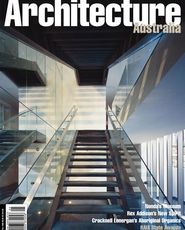|
|
|
|
Project Description Comment by Michael Tawa In its contextural response, the project maintains the integrity of existing heritage buildings on the eastern side of the site, while complementing their orthogonal formalism with curvilinear geometries arranged along an axial arm on the west. This completes the site boundary around an open courtyard between old and new. But these new buildings do not so much enclose a courtyard as open up the entire collection of buildings to their context by framing new readings of the surrounding built and natural environment. The courtyard is on a number of levels, cutting deeply into its site to ground the whole arrangement and provide a vertical emphasis between earth and sky, stepping up towards the north. Around this cutting, screened ramps and balconies weave about the various new spaces on three levels. Remnant masonry foundations and walls, associated with demolished outbuildings, have been stabilised and preserved. They incorporate ledges, sitting walls, landscaping and a bridge across to the new spaces on the west. The old backgrounds the new, which appears to both emerge from it and to locate it within a renewed setting. The courtyard is not so much central as centralising—it is simply there: a kind of sounding board or keynote to the whole composition, and a constant place of reference for the community. Landscaping includes plants from several regions across the nation, representing the different countries and communities which visit and use Tranby. No images, patterns or forms specific to any Indigenous group have been used in the architecture—in the paving, for example—so that the place is not identified as belonging to any particular country, and therefore can remain open to all. The cultural and social program drives the formal two and three-dimensional compositional approach. Curvilinear geometry is used to both centralise and disperse the arrangement, and to cluster together a series of internal and external gathering spaces of different kinds. In fact, what is most important here is a notion of the in-between, carried by a sense of the building as a clearing, or a series of clearings, intermediate between centre and periphery, solid and void, inside and outside, above and below, old and new. The western boundary of the site—extremely well scaled and carefully worked—is fairly vigorously modelled through an alternation between the separate masonry cylinders of meeting rooms and their intermediate open balconies. Here, masonry is used to emphasise a continuity of surface, and to give the whole development a protective and private aspect. By contrast, from the eastern side, the heritage buildings dominate, only barely framing some views into the courtyard, and through to the new buildings. Internally, the masonry walls appear more perforated, and convey less a sense of continuous surface than a rhythm of trabeation. Openings dominate, framed by thick piers and a continuous ring beam from which shallow plaster-lined domes spring to a central vent. The upper parts of the circular spaces recede, with a consequent emphasis on horizontality and expansion beyond their boundaries, towards and through other internal and external spaces, the walls of adjoining buildings, foliage and sky. Each circular meeting place is joined to the numerous layers of a broader external context, constituting a kind of borrowed boundary, which never closes the prospect. Rather, the limits of space are undecidable. They wander and alternate between and across these layers in rhythmic juxtaposition and inter-penetration. The result is an ambiguity which contests conventional ideas of space, where the boundary between inside and outside is either definite and incontestable, or where it is completely dissolved and erased. Here, it is the interminable shifting across borrowed boundaries, effectively located outside the space itself, which creates a sense of indefinite openness. In Western concepts of space, the inside takes causal precedence over an outside which would serve it as a background and setting, and from which it would be alienated. The boundary, as is clear from the example of surrounding heritage buildings, is intended to occlude and occult the private interior domain. Here, though, there is a reversal in the status and hierarchy of inside and outside. Everything is a setting for another setting. Each place is known primarily to the extent that it makes place for other places. What contains interior space is not a boundary wall, but a larger unalienable site which environs the interior, and turns it inside-out. Because of this, space interminably turns and returns—internally to the centre of each space, all spaces together to the courtyard, and the whole development to its local precinct—and each activity maintains its centrality, alongside each other central activity. No one centre dominates. No one form or activity dominates. And any sense of spatial hierarchy is equivalently distributed across the entire site. For this reason, the whole complex appears to work as an urban clearing, which makes room for and locates the community in a very specific way in its very specific environment. These tectonic qualities, of course, engage many of the preferred social protocols which characterise Indigenous processes of education, cultural negotiation and production. The project’s major achievement, in my view, is provisional rather than definitive. Its value lies in the substantial implications and directives which it provides for a reconsideration of certain normative spatial ideas and certain mainstream practices of architectural procurement and production. That it has been realised at all is largely due to a long-standing working relationship of mutual trust between Tranby Aboriginal Cooperative and the architects. A relationship robust enough to carry a relentless and taxing negotiation of conflicting issues and interests, and yet responsive enough to engage and address crucial Indigenous educational and cultural principles around which the Cooperative is organised and sustained. |
Credits
- Project
- Teaching and Cultural Facilities, Tranby Co-operative for Aborigines, Glebe, NSW
- Architect
-
Julie Cracknell and Peter Lonergan
- Project Team
- Julie Cracknell, Peter Lonergan, Michael Chapus, Grant Divall, Charles Chong, David Hong, Samantha Donnelly, Scott Colman, Samantha Morton, Kathleen Chan, Denis Kombumerrie, Timothy Shiu
- Consultants
-
Architect
Merrima Aboriginal Design Unit, NSW Public Works & Services
Builder Brookfield Multiplex
Electrical & hydraulic engineer NSW PW & S
Landscape Ford Civil Contracting Pty Ltd
Quantity surveyor NSW PW & S
Specification Johann Wuhrer & Associates
Structural engineer Partridge
- Site Details
-
Location
Glebe,
Sydney,
NSW,
Australia
- Project Details
-
Status
Built
- Client
-
Client name
Tranby Co-operative for Aborigines with support from the Department of Education, Youth Affairs and Training, Department of Training, Friends of Tranby, the Australia Foundation, Multiplex and Boral
Source

Archive
Published online: 1 Sep 1998
Words:
Michael Tawa
Issue
Architecture Australia, September 1998


















